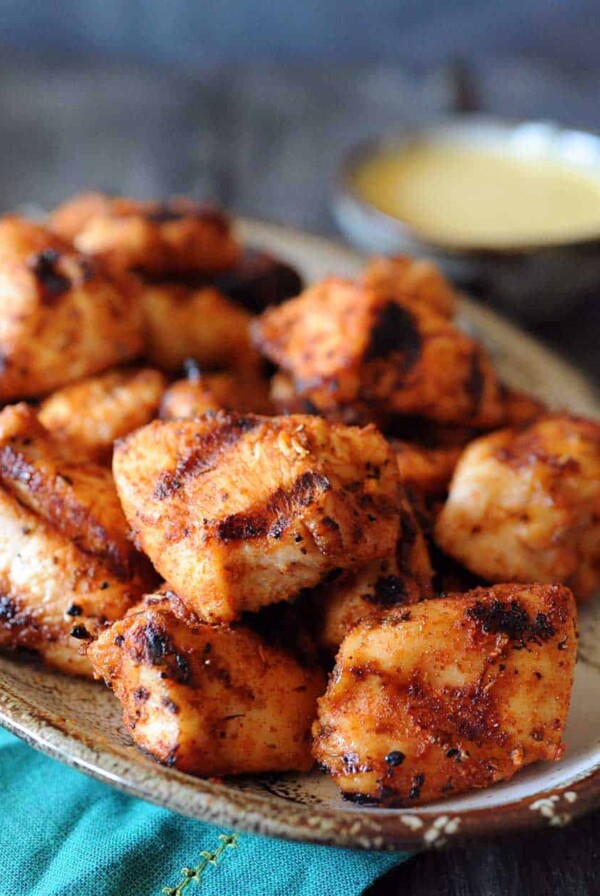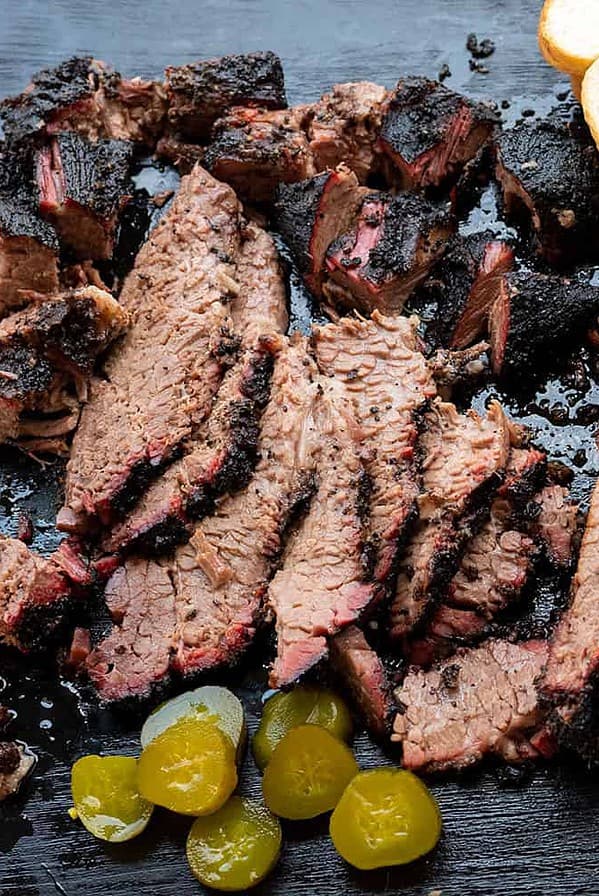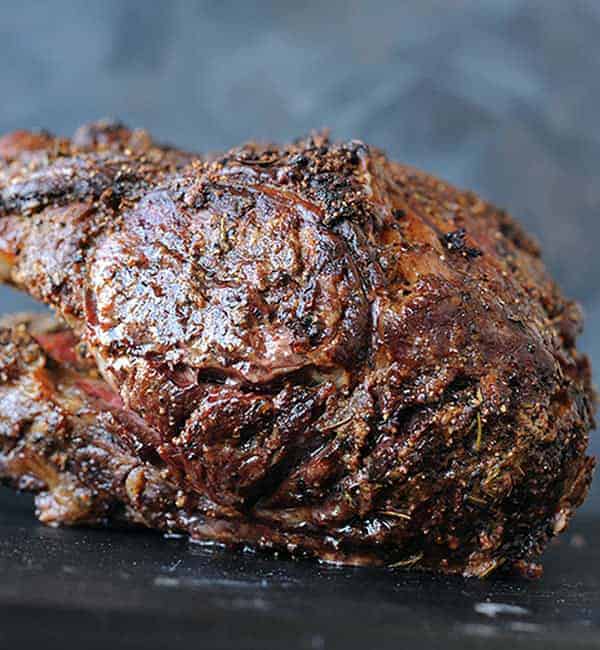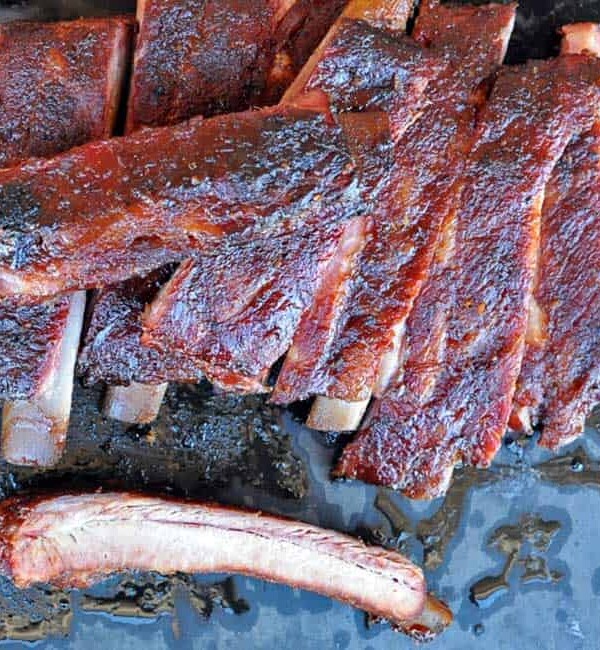We are down to our final KCBS competition meat. Pitmaster Christie Vanover has shared her winning BBQ Tips for chicken, ribs and pork. Now it’s time for competition brisket.
Before we get started on today’s episode, I want to talk to you about a fun demo that I have coming up.

Save this BBQ Tip
Enter your email, and I’ll send this link directly to your inbox. Plus, you’ll get new BBQ recipes and tips weekly.
I’m going to be going to Littleton, Colorado, to Proud Souls Barbecue on July 27, 2024. Be sure to mark your calendar. You’re going to want to come to this. It’s a QU Barbecue University demo.
I’m going to be showing you how to do pulled pork in three different ways, so you can really mix up the meals. I’m also going to show you how to do chicken margherita and fettuccine Alfredo on a griddle, and how to turn your smoker into a bake-type setting so that we can bake rich, indulgent chocolate brownies.
Be sure to visit proudsoulsbarbecue.com and click on their classes. You’ll be able to find the class and sign up.
Listen to the BBQ Tips Podcast on
Table of Contents
- Listen to the BBQ Tips Podcast on
- Competition Brisket BBQ Tips
- What judges look for in the brisket category
- Selecting brisket for competitions
- Trimming a competition brisket
- Injecting and seasoning competition brisket
- Smoking competition brisket
- Slicing and saucing
- Boxing competition brisket
- When to turn in brisket
Competition Brisket BBQ Tips
Brisket is the one meat in a competition that if you can nail it, you have a really good chance at being grand champion. Because what happens is other teams will score good in the other categories. But when it comes to brisket, their scores may fall a little bit flat.
So whatever team can get up there and get top ten and brisket, usually that helps them from the other categories and it just boosts them to the top and it gets them to that GC or RGC position.
Today, I’m going to talk to you about how I do my brisket. I actually placed fifth place in the world at the Jack Daniel’s World Championship Invitational in 2022, with my recipe and technique, so hopefully my technique will help you guys get some calls.
What judges look for in the brisket category
Just like the other categories, I want to talk to you about what is taught in the judges’ class and exactly what the judges are looking for.
First of all, when it comes to brisket, there are two muscles in the brisket the point and the flat. You can turn in either part of the muscle or both parts of the muscle.
You can turn in slices, burnt end cubes, pulled or chopped brisket. Whatever you decide is totally fine. You just have to have six portions in the box.
Technically, it is legal to do three slices of brisket flat and three burnt end cubes, but that is a little bit risky because your scores are going to vary greatly because the judges aren’t tasting the same thing.
Like all other categories, the judges are not allowed to mark you down for what they expect to see in the box. So they can’t expect to get burnt ends and then if they don’t get them, mark you down for it.
They’re just supposed to judge what they have in the box and how good that taste, tenderness and appearances for that category.
There is no requirement for how thick or thin your brisket slices have to be. A lot of people will do a quarter inch or so, but again, if they’re super thin or if they’re super thick, that’s completely up to you.
And a judge should not score you down for that. However, the thickness of your slice may affect the tenderness and the mouthfeel. We’ll talk about that a little bit later.
If you do decide to put different cuts of meat in the box, like let’s say you want to do brisket slices and brisket burnt ends, then the judges are supposed to give you a composite score for that overall experience. when they taste both meats.
Appearance
Appearance is scored just like all the other categories. The box gets brought to the table. The table captain will open up the box and then show it to all the judges individually and then the judges will score it based on how appealing it looks.
They are not allowed to judge you based on whether you have a smoke ring or not, because that can be artificially created. I have a whole blog post explaining what that process is like.
They’re also not allowed to judge you down if you choose to cut the ends of your brisket slices. Sometimes people will pre trim their brisket flat so that it’s the perfect shape to fit in the box. And sometimes people just cook the whole brisket flat and then they cut it after it’s cooked to fit in the box.
A judge is not allowed to score you down on appearance just because you cut the ends off.
Taste
When it comes to taste, your brisket should taste like beef. That’s what it is.
Sauces and seasonings are of course, welcome, but they should not overpower. So if you’re using a really sweet BBQ sauce, that really might take away from the beefy flavor.
I would recommend with taste, things that have been successful to me, are to go with things that are a little bit more salt, pepper, garlic and that umami richness flavor that just gives you that beefy unctuousness.
Tenderness
Tenderness is usually what gets people tripped up in brisket. They either don’t cook it long enough to where it’s tight, or they cook it too long to where it’s kind of tender and falls apart and may be a little bit mushy.
There are a couple tests that the judges can do to test for tenderness, but ultimately it comes down to the mouthfeel.
The fold test is something they can visually look at to kind of give them an idea, but ultimately it does have to come down to how it feels in their mouth.

They could also do the pull test, which is where they grab at each end of the slice and they pull it apart. If it has some tug and resistance to it, it’s probably going to feel a little bit tight when they taste it.
If it falls apart when they just pick it up off of the placemat or out of the box, then it’s most likely overcooked.
But ultimately, if they do the pull test, they’re supposed to pull it and then take a bite from the center right where it broke off, and then test the tenderness there.
Again, it should chew easily. It should be enjoyable. It should be soft, but not so soft that it’s mushy. And, it should have some character and texture to it, but not so much that you kind of have to chew harder.
If the judges are presented with burnt ends, what they’re looking for with tenderness is: Does it have a melt in your mouth feel? Again, not a mushy feel where it just falls apart, but more of a rich melt in your mouth where it still has some texture.
It can be challenging with burnt ends because there’s a lot of fat in the point muscle, so if you don’t fully render that down, by the time it gets to the judges, it can get a little bit colder and that fat can seize up.
You have to be careful that that fat has fully rendered and melted, so when they bite it, they’re tasting the meat with like a gloss of the rendered fat, as opposed to tasting the fat that still has a lot of chew to it.
Biting a piece of fat that’s not rendered is not as enjoyable.
If you’re turning in burnt ends and you’re not getting good tenderness scores, it’s possible that you just need to let it cook longer so that you get the fat more rendered.
Selecting brisket for competitions
All right, let me talk to you about my whole competition brisket process. It starts with selecting your meat. I highly recommend if you are going to cook in a KCBS competition, that you upgrade the brisket that you would usually cook at home.
Cooking a choice brisket, most likely you’re never going to win a brisket category.
I’ve heard of people who have scored top ten calls with prime brisket, but honestly, the teams that are getting those top ten calls most often are either cooking Snake River Farms Wagyu Gold Grade, or they’re cooking an A9 brisket out of Australia.
Both of those are ideal because they have insane marbling in them, and that marbling is going to create better moisture, better tenderness and overall better flavor.
If you cook a choice or even a prime grade brisket, you’re just not going to have that fat within the muscle fibers. And so it’s not going to get as tender or as flavorful.

I cook with Snake River Farms Gold and I purchase it online. If you guys want to buy one online, you can use code GIRLSCANGRILL and save 10% at checkout.
If I were to pick up a brisket at a grocery store or a barbecue supply store, what I would be looking for is a thick flat, something that’s nicely marbled.
And I also love to have something that has a little bit of flexibility and bends a little bit when I pick it up, because that’s just going to create a better overall product.
But because I buy my briskets online, they do come frozen and I don’t get to select what my brisket looks like. All I get to select is the weight, and I usually go with a 18 to 20 pound brisket.
When I get home, I just have fingers crossed that it’s going to look good. I would say 99% of the time I’m really happy with the briskets that I get from Snake River Farms.
Trimming a competition brisket
If your brisket is cryovaced, which most of them are, you can go ahead and actually leave it in your refrigerator. I leave it in there for 1 to 2 weeks. Mine come frozen, so they need to thaw anyway.
By leaving them in the refrigerator for that long, they’re kind of wet aging, and that gives them more of a rich, beefy, umami flavor.
Then when it’s time to trim my brisket, I actually separate the flat muscle from the point muscle. A lot of people don’t even cook the point anymore. They don’t even turn in burnt ends anymore. But I still like to cook it.
Most of the time I put my burnt ends in the box, but if I don’t, that’s fine. At least I cooked it and we’ve got something to eat after the competition.
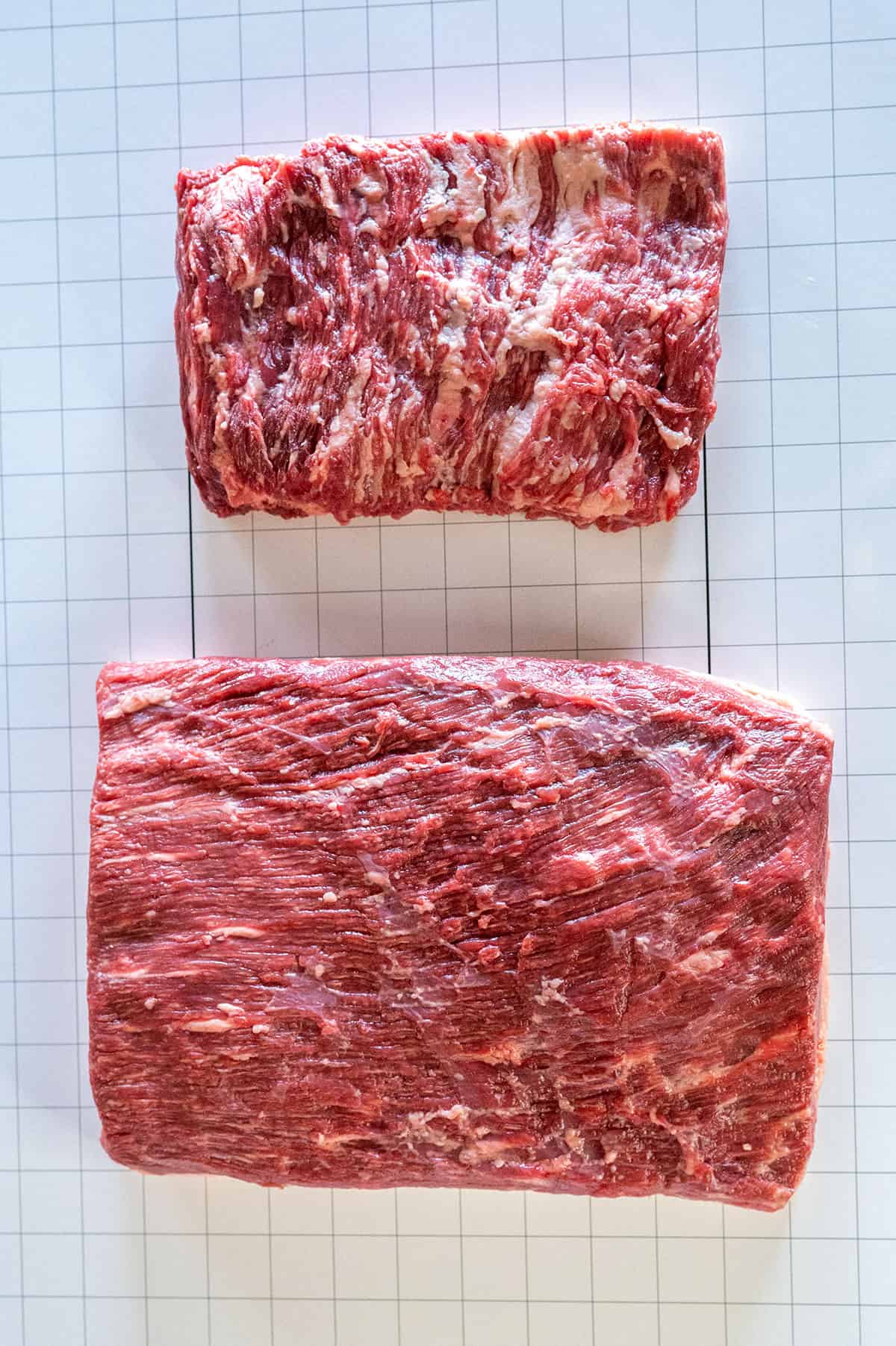
Trimming the flat
Once you get those two separated, you really want to focus on the flat because most of the time that’s the portion that you’re going to turn in.
I always start by shaving off the edges, and then I flip it over and I cut off a big amount of the fat cap that’s on the bottom.
Ultimately, I want my brisket flat to be about two inches thick, so sometimes that fat cap is about a quarter of an inch, and sometimes that fat cap is a little bit thicker. It just depends on how thick the meat portion of the flat is itself.
Then I flip it back over and I shave off some of that extra like silver skin that’s on the top just to make it nice and clean.
The next step is that I square up the brisket flat, and by doing this, I’m cutting off the opposite ends from where I already shaved the sides. You want to make sure that you are perfectly against the grain.
Look at the grain in the meat and then cut perpendicular to that. That way when you go to cut your slices, you’re slicing them all against the grain, which is going to make that slice a lot more tender.
It will look like you’re wasting a lot of meat. You are going to cut off a lot of meat to do a competition brisket trim, but save those trimmings because you can make ground brisket burgers. You can make beef tallow with the fat. There’s so many things that you can do with all the leftovers.
Once I have a nice rectangular shape that’s about two inches thick, I go ahead and I trim the sides a little bit more. I have a cutting board that has a nice grid on it that shows me the exact dimensions of my styrofoam turn-in box.
I usually trim up the sides so that they’re just a little bit bigger than the size of the box itself. Once it cooks, it’s kind of going to compress, and so it’ll shrink just a little bit.
So what you’re left with now is an elongated rectangle that’s 8 1/2 to 9 inches wide, cut against the grain nicely trimmed up and ready. You can go ahead and wrap that cryovac that whatever you want to do, throw it in the fridge until you get to the competition.
Trimming the point
When it comes to the brisket point again, I flip it over and I take off most of the fat on the bottom of the fat cap.
With the meat side up. I actually cut the hump off of the top so that my brisket point is even.
It’s usually about 1 1/2 inches thick, and then I square that up and I usually have a little square or a little rectangle, and I wrap that up and I go ahead and I put that in the refrigerator also.
Injecting and seasoning competition brisket
Once it’s competition time, I get to the competition on Friday, I have my meat inspected, and then it’s time to inject and season.
The brisket injection that I use is a proportion of about a half a cup of a beef marinade powder with two cups of water, or a bottle of water.
I mix that up once I get to the competition and I inject it later that night. I do the flat and the brisket, and I inject with the grain and against the grain. About every inch or so I insert my injection needle into the meat, and then as I press it to put in the injection, I’m slowly pulling it out.
And that’s making sure that that brisket is just full of flavor and phosphates and things that are going to really help tenderize it.
Once I have all the injection in there that I want, I go ahead and pour out any of the drippings that are in the pan.
And then I don’t even pat my brisket dry. I just leave it in the pan and start seasoning it. When it comes to seasoning brisket, this is where it’s totally going to be all about your taste and your preferences.
In my experience, judges love the taste of Texas brisket, which is predominantly kosher salt and coarse ground black pepper. A lot of times people can add garlic powder to it, but there’s so many different brisket seasonings out there on the market.
I have my own brisket blend, which helped me win fifth in the world. Unfortunately, it’s out of stock right now, but I am working on getting it produced so that I can get it back out to you guys soon.
Whatever brisket rub you use, be sure to season your brisket liberally. I cover the full top of the flat so that you can barely see any of the grain of the meat. I don’t worry about the bottom, and I rarely hit the sides, but you’re welcome to do that if you want to.
Once it’s fully injected and seasoned, I leave it uncovered and I put it in my Cambro and let it rest overnight until it’s time to cook it the next morning.
Smoking competition brisket
When it comes to cooking brisket, I cook on my Hunsaker Smokers, as you guys all know. I load it up with Cowboy lump charcoal and charcoal briquets.
And for brisket I use wood chunks that are cherry, post oak and pecan.
My brisket cooks a little bit hotter than the rest of my meats. I get my smoker set to 325 to 350F degrees.
What this is going to do at that high heat level is really force that brisket to kind of plump up in the center, which is going to create thicker brisket slices.
My Hunsaker Smoker has multiple racks. So on the bottom rack I put a half pan full of warm water pushed to one side. Then I add an upper rack and I place my brisket flat over the water pan and my brisket point over the area where there’s no water pan.
Once my brisket is on the smoker, I cook it for about three hours.
During this time I flip my flat over. I flip my point over. I do rotate them towards the end so that the flat is directly over the coals. That just gives it a little bit more intense heat, but I do a little bit of rotation.
Ultimately, what I’m looking for during that three hour period is I want to see the fat start to render on that brisket point. I want to start to create a bark. Obviously, I want that smoke to infuse into the brisket. And then I also want that temperature to be like 165-175F.
Wrapping brisket
Once that three-hour mark is up, it’s time to wrap the brisket and do a braise.
When it’s time to wrap the brisket, I have two aluminum foil pans on the counter.
With one of them. I have two layers of foil in the pan. That’s for the brisket point. For the flat, I just put that in my half pan with the fat side down and I add my mop.
My mop has water, some beef consommé from Campbell’s, some of my brisket rub, and another rub all mixed together. And I just pour that all around the brisket.
There’s enough mop in that pan that the liquid comes about halfway up the side of the brisket.
I spoon a little bit of softened beef tallow on top and hit it with a little bit more beef rub. Then I cover it with foil tightly and put it back on the smoker.
For the brisket point, I like to wrap that in foil instead of just placing it in the pan, because it’s a smaller piece of meat, and I don’t want it to have so much air. I want it to be closer to the moisture, closer to the mop.
So I place it on the two sheets of foil, fold up the edges to kind of create a boat, pour some mop inside, add some tallow on top with a little bit more rub and fold up that foil tightly.
I do keep it in an aluminum pan just in case it leaks. And then I put that on the smoker next to the flap and let them keep riding.
While you’re brisket’s in the mop, it’s going to take about two hours for it to reach the ideal temperature. You want to check it every now and then and just probe it to see how it’s doing.
Ultimately, you want that probe to go into the brisket and just feel soft like butter again, like I talked about with the money muscle, you want it to just be like going into a really ripe peach versus an unripe peach.
That’s the feeling that you should get when you insert your thermometer into your point and your flat.
With my brisket flat, my target temperature is usually around 209 to 210F. But again I’m going on feel more than anything.
My brisket point usually finishes at about 214F or so because I’m cooking Snake River Farms Gold, you’ve got to take it really far to render all that fat. Otherwise it’s going to be chewy.
I should mention that during this process I do like to flip my flat.
I put it in the pan with the fat side down, and then I let it cook to about a temperature of 185F. And then I flip it over and let it continue to cook until it reaches that nice soft temperature. Then once it reaches that point, I flip it back over so that the meat side is on top.
I do remove the foil, hit it with a little bit of rub, and let it go for another 20 to 30 minutes.
This is a technique that I decided to experiment with after judging The Jack multiple times.
One of the primary comments that I kept getting from the judges and kept hearing from judges at my table, was that there was no bark, and it just didn’t have that smoky flavor of Texas brisket.
So by taking the foil off and letting some more smoke get back into that, recreating that bark, you’re getting some of that enhancement.
One thing that some cooks will also do in this stage is they’ll brush it with a little bit of barbecue sauce, add some wood pellets or wood chips on to the smoker, and then that’s going to create that smoke.
That’s going to adhere, and it’s also going to help reinforce your bark. So you can give that a try.
One word of caution when you do this method, once you remove the foil, your brisket might be probing beautifully and you might be at an internal temperature of 210F or whatever your goal temperature is.
When you take that foil off, you’re obviously introducing kind of cooler air in, different air. The brisket temperature is going to drop. Mine has sometimes dropped 15 to 20 degrees.
It’ll get back down to 185-190F and really really throw me off to the point where I’ve continued to cook my brisket thinking what happened? I thought it was ready, but I guess it’s not ready. And then when I go to slice it, it’s completely over.
So sometimes, those temperature numbers will really get in your head and really throw you off. So don’t focus on that. Once you know your brisket is done and probing gorgeous, take the foil off. Just go 20 to 30 minutes. Don’t even worry about how it probes or how the temperature is. It’s going to be spot on.
Holding brisket
So after that 20 to 30 minutes, then you can go ahead and cover it back up with foil and throw it in the Cambro until it’s time to slice it and prep it for turn ins.
When it comes to brisket point, I like to let that baby ride because it has got to render.
A lot of times what I’ll do is once it reaches temperature, once I put that probe in there and it’s amazing, I’ll actually just shut down the grill and leave the brisket point on the smoker itself, and I leave it there to hold until it’s time for turns. That’s just going to keep that fat really nice and rendered.
Honestly, when it comes to a Snake River Farms Gold brisket, if you just let that point keep riding, it’s going to make it even better.
Slicing and saucing
All right, you’ve got your pork turned in. Now the moment of truth. Time to slice into your brisket and get it ready. So I take my brisket flat out of the smoker and you’ve got a pan of that jus of that mop that’s still in there.
You’re welcome to strain that. Some people do. Sometimes I do, sometimes I don’t. Just depends on what my mood is and what the Jew looks like at the time being.
If you have a glossy sheen of fat in that jus, you definitely want to run it through a gravy strainer. That way, you’re going to get just the liquid and get that slimy, greasy feel out of your jus because you don’t want that.
But if you don’t see all that and everything still looks good, then don’t worry about straining.
Prepping the flat
Place your brisket on the cutting board. I use a really long serrated knife from Cutco and I start doing my slices. I wait until I get to about the center and then I start looking at the feel.
Then, I kind of give it a wave to see if it’s tight, to see if it’s tender. I’ll fold it over. I’ll do the pull test. I take a bite.
From there, what I’m trying to figure out is: Is it too tender? Is it just right, or is it just a little bit tight?
If it’s tight, my slices are going to be thinner, because that way it’s going to break off better in their mouth.
If I’m over and it’s actually a little bit mushy, my slices are going to be a little bit thicker, because that’s going to kind of maintain the integrity and the character of the meat, so hopefully it won’t fall apart when they go to bite it.
Ideally I want it to be just perfect. And if it is, then my slices are usually about the thickness of a pencil or about a quarter of an inch thick.
Once I figure out the thickness that I want, I go ahead and I continue slicing down the brisket until I have at least seven or eight, maybe nine slices, and I place them all back in the pan of jus so that they can stay nice and moist.
When I’m testing it for tenderness and taking that bite, I’m also testing it for taste. That’s the moment where I decide: Does this taste beefy? Does it have the umami and the really pop that I want?
If not, that’s where I’ll sprinkle on a finishing rub. It can be something as simple as salt. It can be a little bit of MSG or one of your favorite finishing rubs. Just make sure that it’s light.
If you aren’t familiar with finishing rubs, a lot of times what cooks will do is they will take their favorite seasoning and actually grind it up in a spice grinder so that it’s more like a fine powder.
There’s also these types of spice grinders that you can do in your hand, where you just put like a tablespoon of spice, rub in the little container, and then you use your thumb and it will allow the like really fine grains of that spice to go on to your brisket.
Prepping the point
Now that my brisket slices are done and they are in the pan, I go ahead and take out my brisket point and see how it is. Most of the time, like I said, I turn and burnt ends because I just think they taste amazing. So once I pull them out of the foil, I go ahead and I slice them into cubes.
Usually, I slice off all of the edges so that they’re nice and squared up, and then I make sure that each cube is about the same size. I have a cutting board that has one inch grid patterns, and for bananas, I usually make them about 1 1/2 inches thick.
You also want to make sure to look at the underside of your burnt ends. If there’s a thick fat cap on there, I usually cut that off because I just don’t want it to congeal and harden before the judge gets to taste it. So I cut that off.
I cut all my cubes into even shapes, and then I brush them with some of the jus and I brush them with sauce usually.
Then, I will go and put them back out on the smoker just to set that sauce. You can add a little bit of wood chips or pellets to the smoker at this time also, and that will add to that smoky flavor.
Boxing competition brisket
Now that my burnt ends are ready and my slices are ready, it’s time to put them in the box.
I take 6 or 7 pieces of the slice out of the jus itself, and I lay them on my cutting board.
I brush both sides of the brisket slices with some of that warm jus and some warm barbecue sauce. And then I hit them with a little bit of finishing rub if they need it.
I just make sure they look really moist and they have a nice flavor to them.
Then, I shingle them in my box right on top of the greens. I’ll put the first slice towards the back and then just shingle each slice on top of that.
I make sure that they look nice and even then I use my basting brush and I just brush them again with a little bit of that jus just to give them a little bit of shine.
If I decide to do burnt ends, I will put those all in the front, usually 6 or 7 burnt ends right up in the front. I’ve also done them in the back. How you assemble your box is completely up to you.

If you aren’t doing burnt ends, I do recommend that you either fill your box with brisket slices so you can do more than six. You could do eight if you want, or center those six slices kind of around the green so that everything looks nice and uniform. Not a requirement. But again, everybody eats with their eyes, so you just want it to look really nice and appealing so that you can get a nine on that category.
Once everything’s in the box, I use a wet paper towel to clean up the edges. Take a picture so I can post it on Instagram and just make sure everything looks perfect. That there’s no large grains of black pepper, that everything looks nice and shiny.
Sometimes I’ll even spritz it with some warm water just to give it a little bit extra pop. Then I close the box and turn it in.
When to turn in brisket
One really important word of advice when it comes to turning in brisket, the way that KCBS competitions work is that you should never land on the same table of judges more than once.
So you turn in and chicken is random. The first six boxes that get turned in go to the table one. The next six boxes go to table two.
Well then next time when you turn in ribs, they need to make sure you if you were on table one for chicken, that you don’t go back to table one. So they’re going to wait until they have a tray of styrofoam boxes that they can give to table two, or maybe table three or table four, depending on what time you turned your box in.
Then the next time, let’s say you landed on table one and then table two. Next time you’re gonna land on table three or table four, and then so forth.
When it comes to brisket, they have to make sure that all of the teams land on a completely new table. So it may take a little bit longer to get all of the six boxes for table one, all of the six boxes for table two, etc.
Because of that, the recommendation is that you turn your brisket in closer to the end of the deadline. That way it’s not sitting there waiting.
If you turned it in early and you’re waiting on one more team, it’s going to sit there for up to ten minutes before it actually even makes it into the judges’ area.
If you turn it in toward the last portion of the turn in time, it’s not going to sit there as long and get cold.
This is really important if you’re turning in burnt ends because you want this to be as hot as possible.
Well there you go. Those are all of my tips for my competition brisket. I hope that they were helpful for you. I hope that all of the other episodes have been helpful for you as well.
As always, you can find thousands of barbecue tips and hundreds of barbecue recipes on my site, including my hot and fast brisket and my no-fail slow and low brisket.
You can also find me on all the socials @GirlsCanGrill. If you guys have questions, shoot me a DM. I read all of my DMs, all my emails, and I’m happy to answer any questions that you have.
Until next time guys, good luck if you’re competing. I want to hear if you get those brisket calls and happy grilling.
Tune into more of my BBQ Tips podcasts or scroll around the website for even more helpful BBQ Tips.
